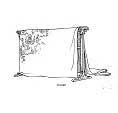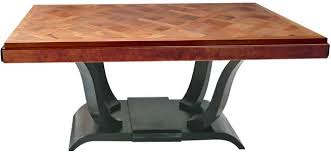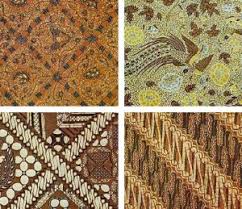Pendulu
 m is made of tin, or wood, or stone dikantongi. Principal function is to hold hanger mori new dibatik not so easily be blown tergeser wind, or pull the pembatik are not intentional. So without the pendulum to make the work can be carried out
m is made of tin, or wood, or stone dikantongi. Principal function is to hold hanger mori new dibatik not so easily be blown tergeser wind, or pull the pembatik are not intentional. So without the pendulum to make the work can be carried out 2.Dingklik 
Dingklik is the place to make people sit, the high adjusted with a high time to make people sit Gawangan Gawangan made of wood or bamboo that is easy to move and move-solid. Gawangan this function to hang up and unfold the fabric will dibatik mori when using the canting

Dingklik is the place to make people sit, the high adjusted with a high time to make people sit Gawangan Gawangan made of wood or bamboo that is easy to move and move-solid. Gawangan this function to hang up and unfold the fabric will dibatik mori when using the canting
3.Pan
 Pan is the tool to withdraw the "night" (for candles to make). Pan is made of metal steel, or clay. Pan should bertangkai that was easily derived from the furnace and take the instrument without the other. Therefore, the pan is made of clay better than that of the metal is not easy because tangkainya summer. But the clay pan heat a bit slow "night".
Pan is the tool to withdraw the "night" (for candles to make). Pan is made of metal steel, or clay. Pan should bertangkai that was easily derived from the furnace and take the instrument without the other. Therefore, the pan is made of clay better than that of the metal is not easy because tangkainya summer. But the clay pan heat a bit slow "night".
 Pan is the tool to withdraw the "night" (for candles to make). Pan is made of metal steel, or clay. Pan should bertangkai that was easily derived from the furnace and take the instrument without the other. Therefore, the pan is made of clay better than that of the metal is not easy because tangkainya summer. But the clay pan heat a bit slow "night".
Pan is the tool to withdraw the "night" (for candles to make). Pan is made of metal steel, or clay. Pan should bertangkai that was easily derived from the furnace and take the instrument without the other. Therefore, the pan is made of clay better than that of the metal is not easy because tangkainya summer. But the clay pan heat a bit slow "night". 4.Anglo (stove)
Anglo made from clay, or other materials. Anglo is the tool as a heating furnace "night". Iron stove is made from the given axis .. When the brazier practice, the materials to make a charcoal fire is wood. If you take the wood brazier was replaced with the cool, cool This is a lot of people in the villages. Cool on the same principle with the brazier, but not graded.
made from clay, or other materials. Anglo is the tool as a heating furnace "night". Iron stove is made from the given axis .. When the brazier practice, the materials to make a charcoal fire is wood. If you take the wood brazier was replaced with the cool, cool This is a lot of people in the villages. Cool on the same principle with the brazier, but not graded.
 made from clay, or other materials. Anglo is the tool as a heating furnace "night". Iron stove is made from the given axis .. When the brazier practice, the materials to make a charcoal fire is wood. If you take the wood brazier was replaced with the cool, cool This is a lot of people in the villages. Cool on the same principle with the brazier, but not graded.
made from clay, or other materials. Anglo is the tool as a heating furnace "night". Iron stove is made from the given axis .. When the brazier practice, the materials to make a charcoal fire is wood. If you take the wood brazier was replaced with the cool, cool This is a lot of people in the villages. Cool on the same principle with the brazier, but not graded. 5.Tepas
 Tepas is not used if using a stove fireplace. Tepas is a means to raise the fire needs; made of bamboo. Besides Tepas, also used ilir. Tepas and ilir at any rate the same, only different forms. Tepas rectangle-shaped and taper on one side and the breadth tangkainya located on the taper is.
Tepas is not used if using a stove fireplace. Tepas is a means to raise the fire needs; made of bamboo. Besides Tepas, also used ilir. Tepas and ilir at any rate the same, only different forms. Tepas rectangle-shaped and taper on one side and the breadth tangkainya located on the taper is. 6.Table cloth
 Work table cloth to cover and protect the thigh pembatik drops of wax from the canting night. Kemplongan Kemplongan is a tool made of wood in the table and hammer hammer tool is used to refine the cloth before mori give batik motifs and patterns dibatik.
Work table cloth to cover and protect the thigh pembatik drops of wax from the canting night. Kemplongan Kemplongan is a tool made of wood in the table and hammer hammer tool is used to refine the cloth before mori give batik motifs and patterns dibatik.
 Work table cloth to cover and protect the thigh pembatik drops of wax from the canting night. Kemplongan Kemplongan is a tool made of wood in the table and hammer hammer tool is used to refine the cloth before mori give batik motifs and patterns dibatik.
Work table cloth to cover and protect the thigh pembatik drops of wax from the canting night. Kemplongan Kemplongan is a tool made of wood in the table and hammer hammer tool is used to refine the cloth before mori give batik motifs and patterns dibatik.7.Canting
Canting is a tool for painting or drawing a stroke with a candle in the night cloth mori.
This canting batik determine the name that will be produced batik. The tool is made from a combination of copper and wood or bamboo that have a flexible and lightweight nature.





